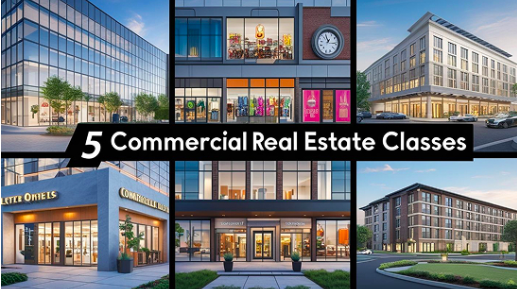The 5 Main Types of Commercial Real Estate Classes
Commercial real estate (CRE) is a powerful investment vehicle—but not all CRE assets are created equal.
From office buildings to industrial warehouses, each property type comes with its own risk profile, income potential, and management requirements.
As a passive investor, understanding the five major classes of commercial real estate will help you make smarter decisions—and recognize where the biggest opportunities lie.
🏢 1. Office
These include buildings used for business operations, ranging from small professional suites to high-rise corporate headquarters.
Pros: Long-term leases with professional tenants
Considerations: Demand can fluctuate with remote work trends and economic shifts
Best for: Investors seeking stable income and prime locations in growing cities
🏬 2. Retail
From shopping centers to single-tenant stores (like banks or fast food), retail properties serve consumer-facing businesses.
Pros: Strong anchor tenants can boost traffic and income
Considerations: Sensitive to consumer trends and online competition
Best for: Investors who understand local markets and tenant mix strategies
🏭 3. Industrial
This includes warehouses, manufacturing plants, and distribution centers—one of the fastest-growing CRE sectors.
Pros: High demand from e-commerce and logistics, long-term leases, lower maintenance
Considerations: Location and transportation access are critical
Best for: Investors seeking low-turnover, income-generating assets with growth potential
🏨 4. Hospitality
Hotels, motels, and extended-stay facilities fall under this category.
Pros: High upside in strong tourism or business travel markets
Considerations: Income is directly tied to occupancy rates and economic cycles
Best for: Experienced investors comfortable with market fluctuations and seasonal revenue
🏢 5. Multifamily (5+ Units)
Multifamily CRE includes apartment complexes with five or more residential units, and is one of the most accessible commercial asset classes.
Pros: Strong demand, steady rental income, and easier financing compared to other CRE types
Considerations: Active management is required unless outsourced
Best for: Investors looking for scale, reliable cash flow, and tax benefits
Why It Matters
At RJ Bowden Companies, we help investors strategically access commercial real estate opportunities across asset classes—with a focus on multifamily and industrial properties for their resilience, demand, and long-term value.
Whether you're just learning the ropes or ready to scale your portfolio, understanding these CRE classes is the first step toward smart, informed investing.

